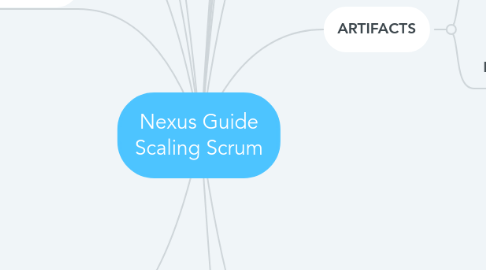
1. - Was any work left undone? Did the Nexus generate technical debt? - Were all artifacts, particularly code, daily successfully integrated? - Was the software successfully built, tested, and deployed often enough to prenvent overwhelming accumulation of unresolved dependencies?
2. Part 1. Make shared issues transparent to all teams. Opportunity for appropriate representatives from across a Nexus to meet and identify issues that have impacted more than a sigle team Part 2. Each Scrum team holding their own Sprint retrospective Part 3. Opportunity for appropriate representatives from the scrum teams to meet again and agree on how to visualize and track the identified actions (allows the Nexus as a whole to adapt)
3. - Nexus (n): a relatioship or connection between people or things - Is a process framework consisting of roles, events, artifacts and rules that bind together the work of 3 to 9 scrum teams working on a single Product Backlog to meet an Integrated Increment.
4. DEFINITION
4.1. Purpose
4.1.1. - refinement continues until the product backlog items are suficciently independent to be worked by a single Scrum Team
5. EVENTS
5.1. Refinement
5.1.1. to coordinate the activities of all Scrum teams for a single sprint to discuss and review the refined product backlog
5.1.2. Purpose
5.2. Nexus Sprint Planning
5.2.1. Attendees
5.2.1.1. - representatives from each Scrum Team
5.2.1.2. - all members of the Scrum Teams (to minimize communication issues)
5.2.2. Output
5.2.2.1. Nexus Sprint Goal
5.2.2.1.1. describes the purpose that will be achieved by scrum teams in the sprint sum of all the work and Sprint goals of the scrum teams
5.2.3. Sprint planning
5.2.3.1. - After understanding the overall work for the Nexus, scrum teams perform their own Sprint Planning - Nexus Sprint Planning is complete when each scrum team has finished individual Sprint Planning.
5.3. issues and work identified during the Nexus daily scrum are taken back to be planned on their individual Daily Scrum
5.4. NEXUS DAILY SCRUM
5.4.1. Attendees
5.4.1.1. appropriate representatives from individual Dev teams
5.4.2. Purpose
5.4.3. Daily Scrum
5.5. Spint Retrospective
5.5.1. Frequency, duration and attendance is based on the dependencies in the product backlog Is continous thyoughout the Sprint as necessary and appropriate
5.6. NEXUS SPRINT RETROSPECTIVE
5.6.1. - a set of Sprint Goals aligned to the Nexus Sprint Goal - each Scrum Team's Sprint Backlog - a Single Nexus Sprint Backlog
5.6.2. to inspect the current state of the integrated increment and to identify integration issues or cross-team dependencies/impacts to inspect progress toward the Nexus Sprint Goal
6. team Members
7. Integrated Increment
8. - has overall responsibility for ensuring the Nexus framework is understood and enacted *may be a Scrum Master in one or more of the Scrum Teams
9. is the current sum of all integrated work completed by a Nexus must be usable and potentially releasable
10. PURPOSE
10.1. - Is a framework for developing and sustaining scaled product initiatives. - It uses Scrum as its building block. *more attention is paid to dependencies and interoperation between Scrum Teams.
10.2. Dependencies
10.2.1. - Requirements: scope may overlap and implementation may affect each other. should be considered when ordering and selecting items - Domain Knowledge: should be distributed across the Scrum Teams (to minimize interruptions between teams). - Test artifacts: Dependencies of requirements, domain knowledge and software artifacts should drive the organization.
11. ARTIFACTS
11.1. Product Backlog
11.1.1. All teams uses the same Product Backlog
11.1.2. Ready items - it must be understood at a level where dependencies can be detected and minimized
11.1.2.1. PO is accountable for it, including its content, availability and ordering
11.2. Nexus Sprint Backlog
11.2.1. Exists to assist with transparency during the sprint it highlight dependencies and the flow of work during the sprint updated daily
11.2.2. All Scrum Teams mantain their individual Sprint Backlogs
11.2.3. is the composite of the product backlog items from the sprint backlogs of individual teams
12. ROLES
12.1. NEXUS INTEGRATION TEAM
12.1.1. Role
12.1.1.1. - Coordinate, coach and supervise the application of Nexus and the operation of Scrum - Highlight awereness of dependencies and cross-team issues - Accountable for ensuring that a "done" integrated increment once every sprint - Might perform work from product backlog - provides a focal point of integration for the Nexus (scrum teams may address integration issues)
12.1.1.2. is responisble for maximizing the value of the product and the work performed and integrated by the scrum teams is a member of the NIT
12.1.2. Team
12.1.2.1. Product Owner, Scrum Master and Nexus Integration Team Members *members of the Nexus Integration Team are often also members of the individual Scrum teams (they must give priority to their work on the Nexus Integration Team to thelp ensure that the work to relsolve issues affecting many teams has priority)
12.1.2.2. Composition of the team may change over time to reflect the current needs of a Nexus
12.1.3. PO
12.1.3.1. - professionals who are skilled in the use of various tools and practices - ensure the Scrum Teams whithin the Nexus understand and implement the practices and tools needed to detect dependencies and frequently integrate all artifacts to the definition of "Done" *team members may also work as Dev team members in one or more Scrum Teams.
12.1.4. SM
12.1.4.1. NEXUS SPRINT REVIEW
12.1.4.1.1. to provide feedback on the integrated increment and to adapt the product backlog if needed *it may not be possible to show all work in detail, so techniques may be necessary to maximize stakeholder feedback.
12.1.4.1.2. held at the end of the Sprint
12.1.4.1.3. Purpose
12.2. SCRUM TEAMS
12.2.1. responsible for delivering done increments

